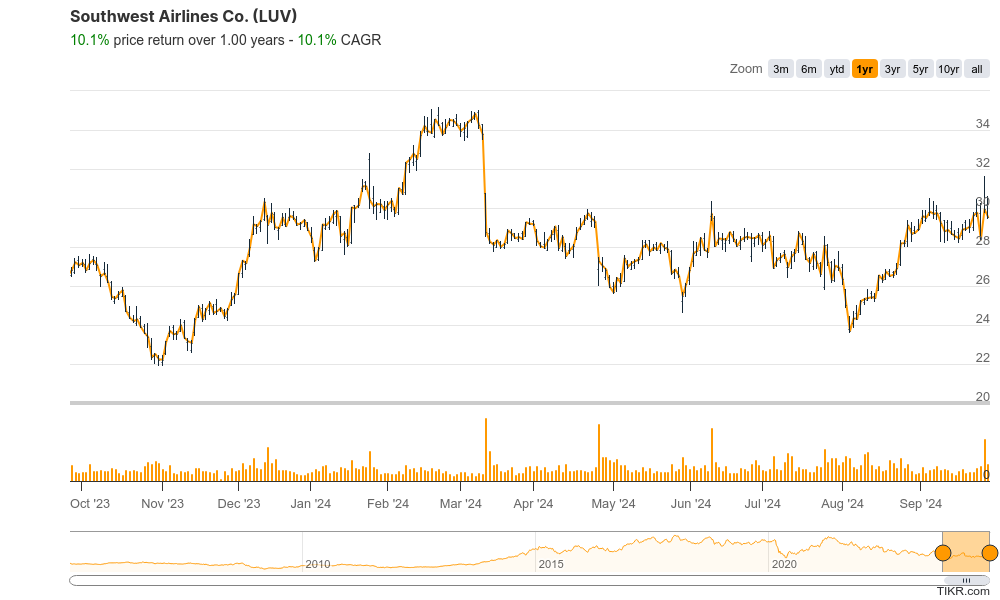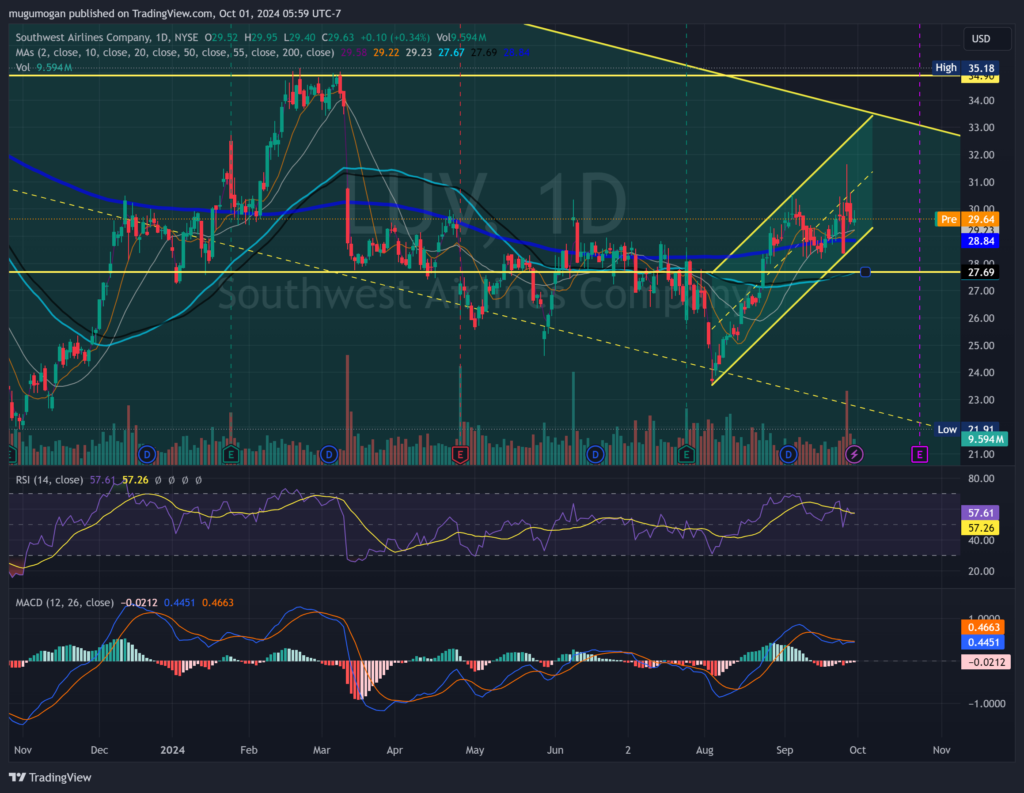Executive Summary:
Southwest Airlines Company is Known for its friendly customer service and no-frills approach, the airline has a vast network of domestic flights. Southwest operates a fleet of Boeing 737 aircraft and has been a significant player in the U.S. airline industry, known for its profitability and customer satisfaction.

Southwest Airlines reported a net income of $367 million, or $0.58 per diluted share. Revenue for the quarter reached a record $7.4 billion, reflecting a 4.5% increase year-over-year.
Stock Overview:
| Ticker | $LUV | Price | $29.53 | Market Cap | $17.69B |
| 52 Week High | $35.18 | 52 Week Low | $21.91 | Shares outstanding | 599.16M |

Company background:
Southwest Airlines was founded in 1967 by Rollin W. King, Herb Kelleher, and John Griggs, Southwest Airlines began operations with three Boeing 737-200 aircraft. The airline’s business model was built on low fares, no assigned seating, and a focus on point-to-point travel rather than hub-and-spoke routes. This innovative approach disrupted the traditional airline industry and set Southwest apart from its competitors.

Southwest Airlines’ initial funding came from a group of San Antonio businessmen, including financier Tom Benson. In 1979, Southwest became the first U.S. airline to offer frequent-flyer miles, further solidifying its position in the market.
Southwest Airlines primarily offers domestic flights within the United States. Its fleet consists of Boeing 737 aircraft, known for their reliability and fuel efficiency. The airline has a strong presence in major U.S. cities and operates a hub-and-spoke system with Dallas Love Field as its primary hub. Southwest is also a member of the Oneworld airline alliance, which allows passengers to earn and redeem frequent-flyer miles on partner airlines.
Southwest Airlines’ key competitors include American Airlines, Delta Air Lines, and United Airlines. These carriers also operate in the U.S. domestic market and compete with Southwest on price, route networks, and customer service. Southwest has maintained a competitive edge through its low-cost model, strong brand recognition, and loyal customer base.
The headquarters of Southwest Airlines is located in Dallas, Texas. The airline has a significant presence in the state and employs a large number of people in the Dallas-Fort Worth area.
Recent Earnings:
Southwest Airlines reported revenue for the quarter reached a record $7.4 billion, reflecting a 4.5% increase compared to the previous year. Net income amounted to $367 million, or $0.58 per diluted share. Southwest’s revenue per available seat mile (RASM) decreased by 3.8% year-over-year due to higher fuel prices and increased competition.
Southwest Airlines’ load factor improved to 84.5% in the second quarter of 2024, up from 82.9% in the same period last year. The airline’s on-time performance also showed improvement, reaching 80.9%, compared to 79.8% in the prior-year quarter. Southwest expects unit revenues to remain flat or decline by 2%, while capacity is projected to increase by around 2%.
Southwest Airlines faces several challenges, including rising fuel costs, increased competition, and the ongoing impact of the COVID-19 pandemic on travel demand. The airline remains optimistic about its long-term prospects and continues to focus on its low-cost business model, strong brand recognition, and customer-centric approach.
The Market, Industry, and Competitors:

Southwest Airlines primarily operates in the U.S. domestic market, serving a vast network of destinations across the country. They have maintained a strong market position through its low-fare model, customer-centric approach, and efficient operations.
The U.S. airline industry as increasing disposable income, rising air travel demand, and economic expansion. Southwest Airlines is well-positioned to capitalize on this growth, with its focus on serving the leisure and business travel segments. The airline’s expansion plans, including the addition of new routes and aircraft, are expected to support its growth trajectory.
Southwest Airlines will achieve a compound annual growth rate (CAGR) of around 4-6.5% in terms of revenue and earnings. This growth is anticipated to be driven by factors such as increased air travel demand, higher fares, and improved operational efficiency. The airline’s growth prospects may be impacted by various factors, including fuel price fluctuations, economic downturns, and competitive pressures.
Unique differentiation:
American Airlines: Based in Fort Worth, Texas, American is the largest airline in the world by fleet size and revenue. It operates a vast network of domestic and international flights and competes with Southwest on many routes.
Delta Air Lines: Headquartered in Atlanta, Georgia, Delta is the third-largest airline in the world. It offers a comprehensive network of domestic and international flights and competes with Southwest, particularly in the southeastern United States.
United Airlines: Based in Chicago, Illinois, United is the second-largest airline in the world. It operates a large network of domestic and international flights and competes with Southwest on many routes, especially in the Midwest and West Coast.

Low-cost model: Southwest has a reputation for offering competitive fares and eliminating many of the traditional airline fees, such as baggage fees and assigned seating. This affordability attracts price-conscious travelers.
Strong customer service: Southwest is known for its friendly and helpful employees, who are often referred to as “Southwest Hosts.” This emphasis on customer service has helped build a loyal customer base.
Point-to-point travel: Unlike many other airlines that rely on hub-and-spoke systems, Southwest primarily focuses on point-to-point travel. This means passengers can often fly directly to their destination without having to make connections. This simplicity and convenience are appealing to many travelers.
Management & Employees:
Robert W. Jordan, Jr.: As the Chief Executive Officer (CEO), Jordan oversees the overall strategy and operations of Southwest Airlines. He has been with the company since 1989 and has held various leadership roles.
Tammy C. Romo: As the Chief Commercial Officer (CCO), Romo is responsible for revenue generation, marketing, and sales. She joined Southwest in 1999 and has held several senior leadership positions.
Gary C. Kelly: As the Executive Chairman of the Board, Kelly provides strategic guidance and oversight to the company. He served as CEO of Southwest for many years and is credited with leading the airline’s growth and success.
Financials:

Southwest Airlines Company has reported revenues of approximately $22.43 billion. In 2020 revenues plummeted to around $9.05 billion due to travel restrictions and reduced demand, marking a dramatic decline of about 60% year-over-year. The subsequent years saw a gradual recovery, with revenues rebounding to approximately $15.79 billion in 2021 and reaching about $23.81 billion in 2022. The revenues were projected at around $26.09 billion, reflecting a compound annual growth rate (CAGR) of approximately 14.5% from 2020 to 2023.
Southwest reported a net income of roughly $2.96 billion in 2019. The pandemic led to substantial losses in 2020, with a net income loss of approximately $3.68 billion. In 2021, the airline returned to profitability with a net income of about $1.72 billion, which further increased to approximately $1.00 billion in 2022 and was projected at around $633 million for 2023. This translates into a CAGR for earnings from the low point in 2020 of about 35%, indicating a strong recovery trend post-pandemic.
Southwest Airlines maintained a total assets reported at approximately $25.90 billion, with total liabilities of about $17.95 billion, resulting in a healthy equity position. The total assets had increased to around $34.59 billion as the company raised capital to navigate through the crisis, while total liabilities also rose to about $22.71 billion. The total assets were estimated at approximately $36.49 billion with total liabilities around $25.97 billion.
The airline’s focus on cost management and operational efficiency will be critical as it continues to navigate an evolving market landscape characterized by fluctuating demand and competitive pressures.

Technical Analysis:
A stage 4 markdown (bearish) on the monthly and weekly charts, which is not a good sign for the stock long term, until it gets past the the resistance at $32. The daily chart is in stage 3, (neutral) which shows some consolidation at this level in the $27 – $29 range. The stock is not at a good point to buy yet.

Bull Case:
Growth potential: The U.S. airline industry is expected to continue growing, driven by factors such as increasing disposable income, rising air travel demand, and economic expansion. Southwest is well-positioned to capitalize on this growth through its expansion plans and focus on serving the leisure and business travel segments.
Operational efficiency: Southwest’s focus on point-to-point travel and its use of a single aircraft type (Boeing 737) contribute to its operational efficiency. This efficiency can help lower costs and improve profitability.
Dividend and buyback program: Southwest has a history of returning capital to shareholders through dividends and share buybacks. This can enhance shareholder value and provide a source of income for investors.
Bear Case:
Fuel price volatility: The airline industry is sensitive to fluctuations in fuel prices. Rising fuel costs can significantly impact Southwest’s profitability, as fuel is a major expense.
Regulatory risks: The airline industry is subject to various regulations, including those related to safety, environmental protection, and labor relations. Changes in regulations could have a significant impact on Southwest’s operations and costs.
Operational disruptions: Southwest has experienced operational disruptions in the past, such as flight cancellations and delays. These disruptions can damage the airline’s reputation and lead to increased costs.